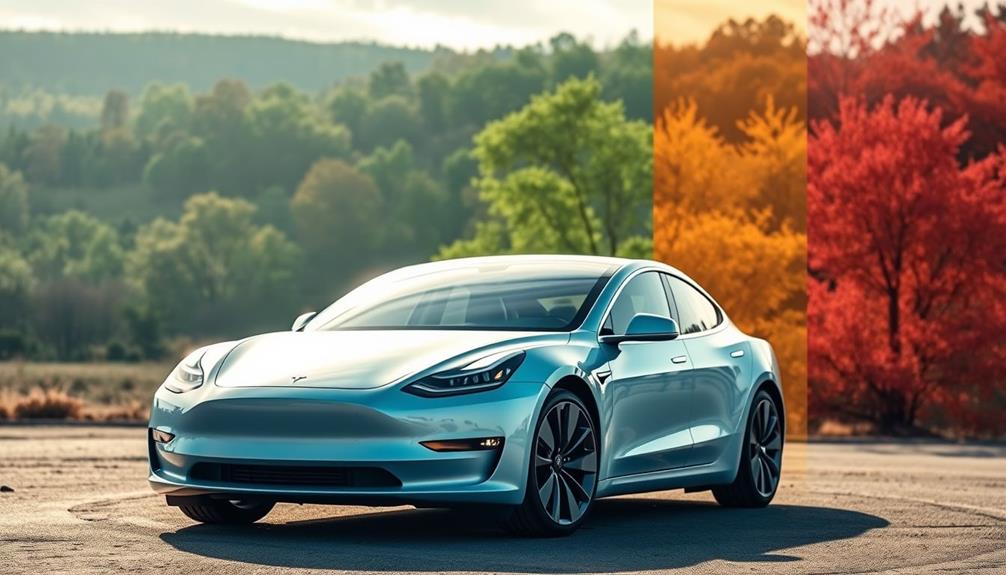You might notice that many people criticize Tesla for various reasons. Concerns about its aggressive workplace culture and high turnover rates often surface. Safety issues, like build quality problems and Autopilot crashes, have eroded consumer trust. Allegations of misleading marketing and fraud, alongside ongoing legal challenges, only add to the criticisms. Environmental practices, like failing to meet air quality standards, contrast sharply with its green image. Plus, customer service struggles, high ownership costs, and privacy worries exacerbate frustrations. There's a lot to unpack here as you explore the depth of these controversies and criticisms surrounding the electric car giant. Despite these criticisms, it’s important to acknowledge the positive aspects as well. Many customers appreciate the innovative technology, performance, and eco-friendly aspects of Tesla’s electric cars. The company’s commitment to pushing the boundaries of electric vehicle development also garners support from environmentalists and tech enthusiasts. Understanding the pros and cons of Tesla ownership is essential for making an informed decision about investing in their products.
Key Takeaways
- Tesla's aggressive corporate culture and chaotic management lead to high employee turnover and a toxic work environment.
- Quality issues, such as poor build quality and safety concerns, erode consumer confidence and raise safety alarms.
- Complaints about inadequate customer service, including long response times and limited repair availability, frustrate owners and diminish their experience.
- Legal challenges, including accusations of false advertising and misleading marketing practices, raise ethical concerns and impact investor trust.
- Environmental practices, such as noncompliance with regulations and reliance on diesel generators, contradict Tesla's green image, leading to consumer skepticism.
General Criticism of Tesla
Tesla's aggressive corporate culture often rubs people the wrong way, leading to a wave of criticism. Employees often report high turnover rates and complicated relationships with management, creating a chaotic work environment. Complaints about poor build quality in Tesla vehicles have also surfaced, fueling concerns about the company's overall commitment to excellence.
Additionally, the company's focus on rapid growth may reflect a lack of proper budget management practices, further exacerbating quality issues.
Moreover, Tesla's business practices have drawn scrutiny, particularly regarding its marketing strategies. Allegations of misleading claims about Autopilot and Full Self-Driving features have triggered investigations by state and federal agencies, raising questions about the integrity of its advertising.
Additionally, the company's environmental practices have come under fire. Tesla has faced accusations of chronic noncompliance with air quality regulations at its Fremont factory, resulting in its removal from the S&P 500 ESG Index in May 2022.
This noncompliance negatively impacts its image as a green alternative in the automotive industry.
These factors contribute to a growing perception that Tesla prioritizes profit over ethical practices, leaving many consumers and critics questioning the brand's true commitment to quality and sustainability.
Safety and Quality Issues

When it comes to safety and quality, many people have raised significant concerns about Tesla vehicles. These issues have led to ongoing scrutiny and investigations, particularly regarding the Autopilot feature.
There are also parallels in the appliance industry, where safety and reliability are vital factors for consumer trust, similar to the appliance maintenance plans that can help guarantee longevity.
Here are three major areas of concern:
- Safety Concerns: Reports of sudden unintended acceleration and brake failures have prompted investigations. The Autopilot feature is linked to around 736 crashes since 2019, with 17 confirmed fatalities, raising serious doubts about its reliability.
- Build Quality Issues: Tesla models have faced consistent complaints about their build quality. Customers often report panel gaps, paint defects, and malfunctioning door handles that freeze in cold weather, undermining confidence in the brand's manufacturing processes.
- Customer Service Challenges: Many Tesla owners have experienced inadequate customer service, facing long response times and difficulties scheduling repairs. These challenges exacerbate safety concerns, as timely maintenance is essential for vehicle safety.
Fraud Allegations and Financial Practices
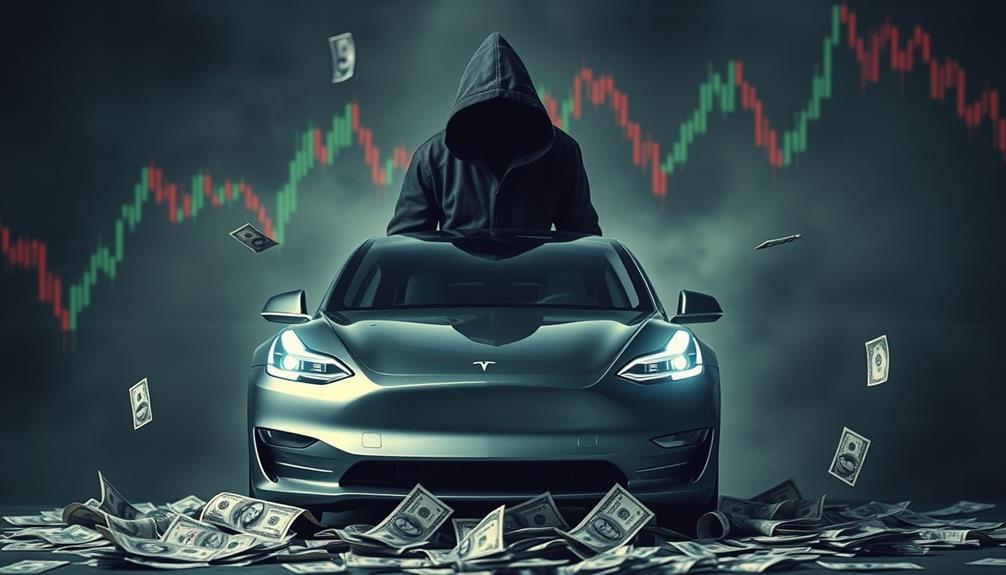
When you look at Tesla's financial practices, you'll notice some troubling allegations.
Issues like high-pressure sales tactics have raised eyebrows among investors and analysts alike.
Shareholder lawsuits and investigations into misleading statements raise serious questions about the company's transparency and accountability.
These issues not only impact investor trust but also contribute to the growing resentment towards Tesla and its leadership.
Misleading Financial Statements
Many investors and analysts have raised red flags about Tesla's financial practices, particularly concerning misleading financial statements. These concerns have led to numerous allegations of fraud and accounting irregularities that cast doubt on the company's transparency.
Effective software quality assurance is vital in ensuring that companies maintain accurate financial reporting and uphold their integrity. Here are three key issues that have emerged:
- Production Figures: Allegations suggest that Tesla may have overstated its production figures, leading to inflated expectations and potential misrepresentation.
- SEC Investigations: The SEC charged Elon Musk and Tesla for making misleading statements, particularly regarding funding to take Tesla private, which a federal judge deemed reckless.
- Whistleblower Complaints: A whistleblower complaint triggered an SEC investigation that uncovered discrepancies in revenue recognition practices, raising fears that Tesla's financial figures were artificially inflated.
These controversies not only affect investor confidence but also highlight a troubling pattern of potential misconduct.
With ongoing scrutiny from regulators and hedge fund managers, the integrity of Tesla's financial statements remains a significant concern.
As an investor or enthusiast, it's essential for you to stay informed about these issues, as they could impact Tesla's long-term viability and reputation in the market.
Shareholder Lawsuit Outcomes
The ongoing shareholder lawsuits against Elon Musk and Tesla highlight significant concerns regarding fraud allegations and financial practices. You might recall the $2.6 billion SolarCity buyout, where Musk faced accusations of breaching fiduciary duties due to conflicts of interest. His infamous 2018 tweet about securing funding to take Tesla private at $420 per share led to SEC charges for misleading statements, resulting in a $20 million settlement and Musk stepping down as chairman.
Additionally, accusations of fraud regarding production figures have surfaced, particularly concerning the Model 3. These misleading statements have certainly shaken investor confidence and impacted stock prices. The Department of Justice even initiated an investigation into potential misrepresentation of production figures in 2018.
Here's a snapshot of key events tied to these lawsuits:
| Year | Event Description | Outcome |
|---|---|---|
| 2016 | SolarCity buyout lawsuit filed | Ongoing litigation |
| 2018 | Musk tweets about taking Tesla private | SEC charges, $20 million fine |
| 2021 | Judge rules on Musk's reckless statements | Musk steps down as chairman |
| 2018 | DOJ investigates production figure claims | Investigation ongoing |
| Ongoing | Accusations impact stock prices | Investor confidence shaken |
These controversies continue to affect Tesla's reputation.
Marketing and Legal Challenges

You might find it alarming that Tesla has faced multiple accusations of false advertising, especially concerning its Autopilot features.
Misleading claims about automated driving capabilities have drawn scrutiny from authorities, leading to ongoing legal investigations.
This situation highlights the importance of content quality and topical authority in establishing trust with consumers.
As these challenges unfold, they raise serious questions about the integrity of Tesla's marketing strategies.
False Advertising Accusations
False advertising accusations have plagued Tesla, raising serious concerns about the company's marketing practices. In August 2022, the California DMV formally accused Tesla of misleading consumers regarding its Autopilot and Full Self-Driving capabilities. German authorities also ruled in 2020 that Tesla's marketing misrepresented the automated driving features of its vehicles. These incidents highlight a troubling trend in Tesla's promotion of its technology.
Additionally, just as with cold medications overview, where the significance of clear communication about effects and side effects is emphasized, Tesla's marketing practices warrant similar scrutiny for transparency.
Here are some key points to reflect on:
- Legal Challenges: Tesla faces multiple lawsuits, including one from Texas police, alleging systematic fraud related to Autopilot functionality.
- Regulatory Scrutiny: A higher court reversed a ban on misleading marketing, allowing Tesla to continue certain tactics but requiring clearer consumer information.
- Fraudulent Behavior Concerns: Legal scholars suggest that Tesla's misrepresentation of Full Self-Driving technology could potentially be deemed fraudulent.
The combination of these accusations and ongoing scrutiny raises valid questions about Tesla's approach to marketing. As you think about purchasing a Tesla, it's vital to stay informed about these controversies and understand the technology behind the claims being made.
Misleading Autopilot Claims
Accusations of misleading marketing extend beyond general false advertising to specific claims about Tesla's Autopilot and Full Self-Driving (FSD) features. Critics argue that Tesla's advertising creates a false impression of the capabilities of these technologies, leading consumers to believe they can rely on them for fully autonomous driving. This has sparked significant legal challenges, particularly following the California DMV's formal accusation of false advertising in August 2022.
Additionally, the automotive industry has seen a rise in scrutiny regarding transparent fee structures and truthful marketing practices that guarantee consumer protection.
With multiple investigations by state and federal agencies, including the Department of Justice, concerns over crashes linked to Autopilot use have intensified. Legal scholars suggest that Tesla's misrepresentation of its FSD technology could be seen as fraudulent, raising serious implications under consumer protection laws.
As these allegations mount, lawsuits from entities like the Texas police add complexity to Tesla's legal landscape.
In this context, the company faces a growing backlash as consumers and regulators grapple with the potential dangers of misleading marketing. The outcome of these legal challenges could reshape how Tesla promotes its technologies and influence public perception of the brand moving forward.
Ongoing Legal Investigations
The legal landscape surrounding Tesla is becoming increasingly complex as ongoing investigations scrutinize the company's marketing practices and claims regarding its driver-assistance technologies.
These legal challenges have emerged due to concerns about Tesla's Autopilot system and its portrayal of autonomous driving capabilities. The scrutiny of Tesla's practices may parallel the challenges faced during a divorce, where financial implications and legal responsibilities must be addressed financial implications in divorce.
Here are three key points highlighting these ongoing investigations:
- In August 2022, the California DMV accused Tesla of false advertising related to its vehicle capabilities, intensifying legal scrutiny on the company's promotional strategies.
- German authorities previously ruled that Tesla misled consumers about its automated driving features, prompting further investigations into its marketing claims.
- The Department of Justice is currently investigating Tesla's driver-assistance systems, focusing on safety and marketing practices, which could lead to considerable ramifications.
As these legal battles unfold, Tesla faces mounting pressure to clarify its advertising practices.
The recent lawsuit filed by Texas police alleging systematic fraud regarding its Autopilot system adds another layer of complexity.
With ongoing investigations and legal scrutiny, the company's future marketing strategies may need to shift considerably to regain consumer trust and comply with regulatory standards.
Environmental Practices and Concerns
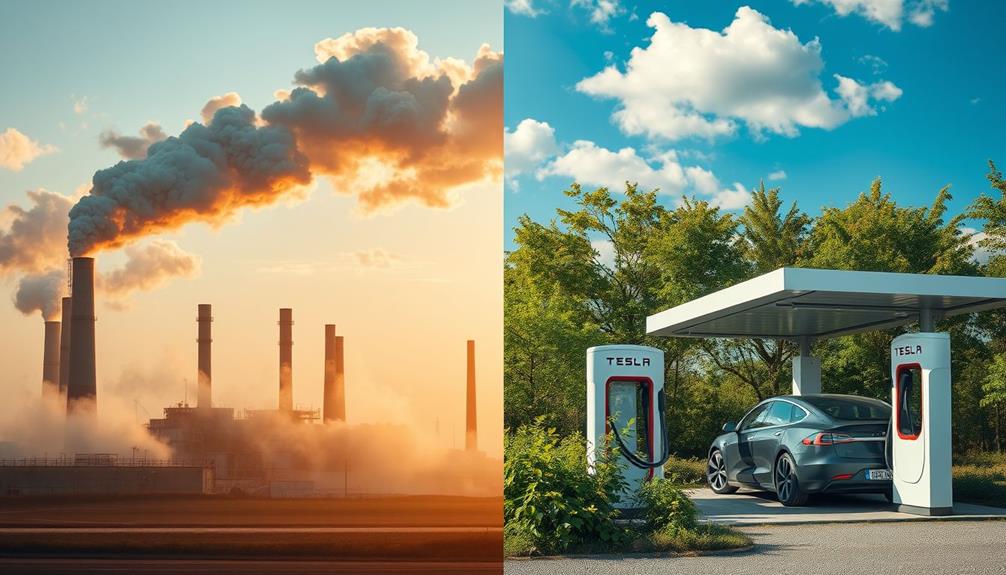
Tesla's environmental practices have come under fire, raising serious concerns among critics and consumers alike. The company has faced chronic noncompliance with air quality regulations at its Fremont factory, racking up 119 violation notices since 2019. This raises questions about its commitment to sustainability.
In May 2022, Tesla was even removed from the S&P 500 ESG Index due to significant environmental concerns, highlighting the scrutiny over its practices. Additionally, concerns about heat pump efficiency in extreme weather conditions add to the discussion of sustainable practices in the energy sector.
Moreover, while Tesla's Supercharger network claimed to be 100% renewable in 2021, it relied on diesel generators for backup power as recently as 2015, casting doubt on its environmental credibility.
The criticism doesn't stop there; the impact of battery production, particularly the mining of lithium and cobalt, poses significant environmental and ethical challenges. These processes contribute to degradation in mining regions, raising alarms about how eco-friendly Tesla's operations truly are.
With these factors in mind, it's no wonder that many consumers are questioning whether Tesla's green image aligns with its actual environmental practices. The gap between perception and reality continues to fuel discontent.
Privacy and Surveillance Issues

Concerns about Tesla's commitment to privacy have sparked significant debate, particularly in light of its environmental controversies.
With multiple in-car cameras capturing footage of drivers and passengers, many worry about unauthorized access to sensitive recordings. The Sentry Mode feature, while aimed at protecting your vehicle, can inadvertently infringe on privacy by recording non-criminal activities.
Additionally, the incident involving CrowdStrike outage disrupts Microsoft services globally underscores the vulnerabilities in technology that are relevant to Tesla's situation.
Here are some key privacy concerns associated with Tesla vehicles:
- Unauthorized Access: There's fear that sensitive footage could be accessed by unauthorized individuals, including employees.
- Data Misuse: Owners express anxiety that recordings might be used for market research or monitoring without their consent.
- Lack of Control: Many feel they lack control over when the cameras activate, leading to discomfort about being watched.
Tesla has introduced software updates to improve privacy, including notifications before recording.
However, skepticism remains about how effectively these measures protect you. As the debate continues, the balance between security and privacy is a pressing issue for Tesla owners, raising essential questions about surveillance in modern vehicles.
Customer Service Challenges
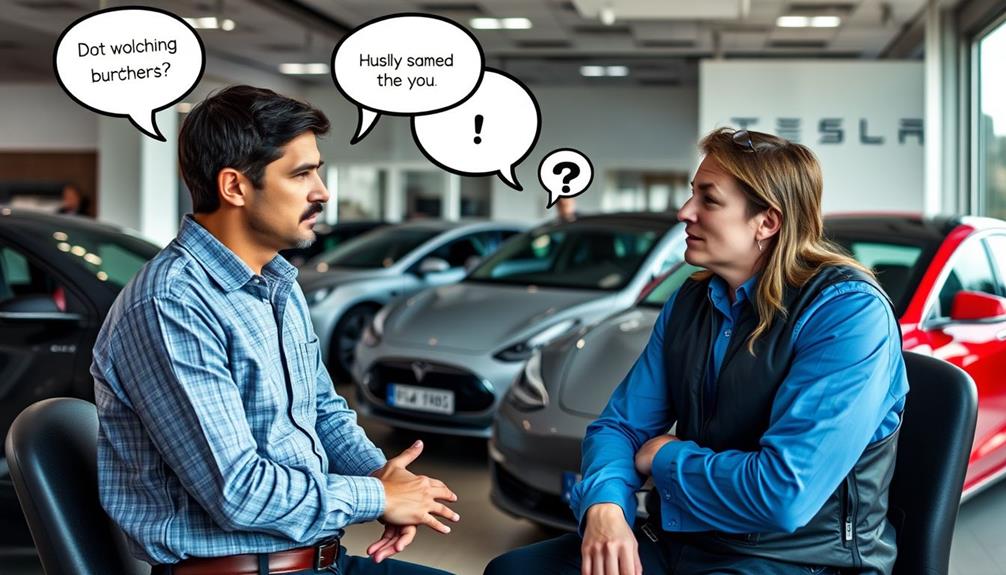
Many owners find themselves frustrated with Tesla's customer service challenges. You might've experienced long response times when trying to get support, leaving you feeling ignored as you navigate quality problems with your vehicle.
Scheduling repairs often becomes a hurdle, as many customers report difficulties in securing timely appointments. This adds to the dissatisfaction, especially when urgent issues arise.
The limited availability of service centers in certain areas only compounds these challenges. If you live far from a center, unresolved issues can linger, making your ownership experience less enjoyable.
Additionally, many Tesla owners have turned to online resources for troubleshooting, but this often feels inadequate. You may find yourself sifting through forums, searching for solutions without the direct assistance you expect.
Moreover, a lack of follow-up from Tesla's service team can create the impression that your concerns aren't a priority. This perception of poor customer service can lead to further disappointment.
Ultimately, these challenges highlight a critical gap in Tesla's support network, leaving many owners feeling unsupported and frustrated throughout their ownership journey.
High Costs of Ownership
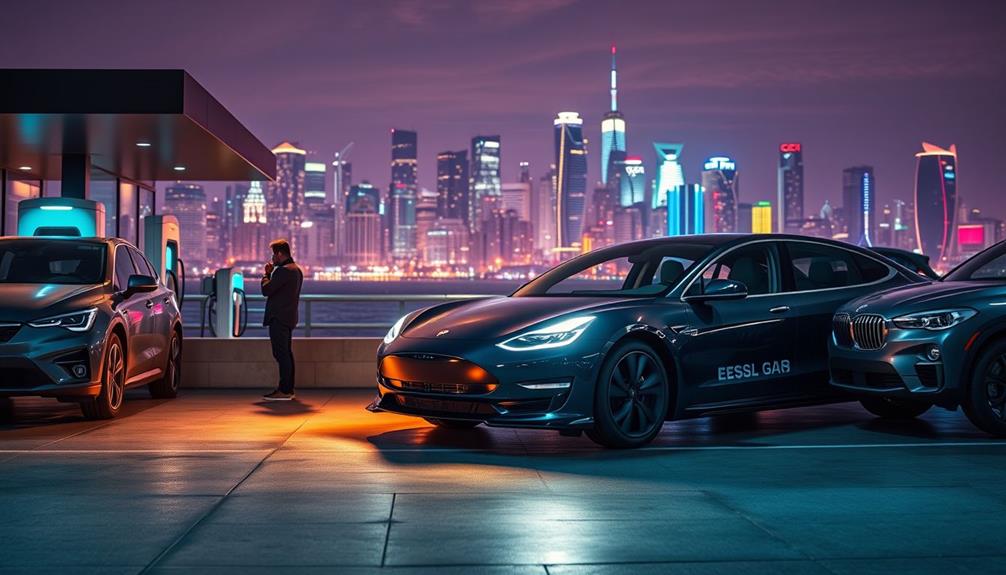
Owning a Tesla can quickly become a financial burden, especially when considering the high costs associated with the vehicle. While the Model 3 presents a lower starting price compared to other Teslas, it still begins around $50,000, which is intimidating for many consumers seeking affordable entry-level models.
Here are a few key factors contributing to the high costs of ownership:
- Insurance Rates: Tesla vehicles often come with elevated insurance premiums, further increasing your monthly expenses.
- Battery Replacement: Should you need a battery replacement, expect to pay around $9,500 for a Model 3, potentially soaring to $16,000 for an extended-range battery.
- Tire Wear: Due to their high-performance design, Teslas experience faster tire degradation, averaging only 40,000 to 50,000 miles before needing new tires.
Additionally, if you live in rural areas, the necessity of investing in a home charging setup can complicate the financial landscape considerably.
All these factors make owning a Tesla more costly than one might initially anticipate.
Workplace Culture and Practices

Tesla's workplace culture often raises eyebrows, as it's been described as aggressive and ruthless. This environment contributes to high employee turnover rates and complicated relationships between staff and management. Many employees report feeling pressure to meet ambitious targets, often at the expense of safety and quality.
The company's approach to accountability is lacking, and whistleblowers face retaliation, creating a defensive corporate culture that downplays employees' concerns. In addition, toxic fan behavior from some Tesla supporters exacerbates the situation. Critics and journalists are often harassed, reflecting a broader culture that discourages dissenting voices.
Here's a quick overview of key aspects of Tesla's workplace culture:
| Aspect | Description |
|---|---|
| Employee Turnover | High rates due to stress and pressure |
| Accountability | Lack of it; whistleblowers face retaliation |
| Safety and Quality | Often compromised for ambitious targets |
| Toxic Fan Behavior | Harassment of critics creates a hostile environment |
Frequently Asked Questions
Why Is There Hate for Tesla?
People often criticize Tesla for perceived deceptive marketing, inconsistent product quality, and a contentious corporate culture. Additionally, Elon Musk's controversial statements and competitive pressures from traditional automakers contribute to the negative sentiment surrounding the brand.
Why Are Teslas Controversial?
Tesla's controversial due to alleged false advertising, safety concerns, and a criticized workplace culture. You might also notice environmental scrutiny and Elon Musk's polarizing public persona impacting how people perceive the brand overall.
What Are the Criticism of Tesla?
You'll find Tesla criticized for its workplace culture, safety issues with Autopilot, misleading marketing, environmental concerns, and poor customer service. These factors contribute to a growing dissatisfaction among employees and consumers alike. One of the most pressing concerns surrounds Tesla car safety, as the company’s Autopilot system has been implicated in a number of high-profile accidents. Additionally, questions have been raised about the environmental impact of Tesla’s manufacturing processes and the company’s reliance on non-renewable energy sources. These issues have led to a decline in public trust and have put pressure on Tesla to address these concerns in a meaningful way.
What Are Some Bad Things About Teslas?
Some bad things about Teslas include build quality issues, safety concerns with Autopilot, poor customer service, environmental impacts from battery production, and software glitches that can lead to recalls and malfunctions in vehicle systems.
Conclusion
In the end, Tesla's controversies reveal a complex relationship with its customers and the public. While some criticisms stem from valid concerns, others may be fueled by the brand's disruptive nature and Elon Musk's polarizing persona. It's worth considering that the intense scrutiny Tesla faces could be a reflection of its ambitious goals and innovative spirit—traits that often invite skepticism. As you weigh these factors, you might find that the truth is often more nuanced than the headlines suggest.


